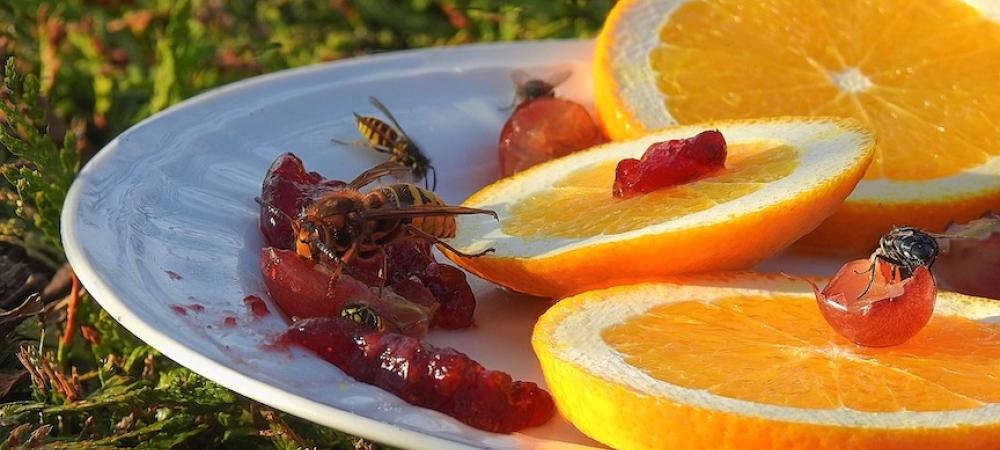The Most Common Stinging Insects In New York

New York State is home to a diverse array of insect species, including several types of stinging insects. While many of them are harmless and play crucial roles in our ecosystem, some can deliver painful stings that can cause allergic reactions in susceptible individuals. In this blog, we will explore the most common types of wasps and bees in New York including:
- Bald-faced Hornets
- Bumblebees
- Carpenter Bees
- European Hornets
- Honey Bees
- Mason Bees
- Mud Daubers
- Paper Wasps
- Sweat Bees
- Yellow Jackets
The 5 Most Common Types of Wasps in New York
In New York, several types of wasps can be commonly found. These insects belong to the Vespidae family and are known for their distinctive appearance and, in some cases, aggressive behavior. Here are some of the most common types of wasps you may encounter in New York:
Yellow Jackets (Vespula spp.)
Yellow jackets are perhaps the most common and recognizable type of wasps in New York. They are small to medium-sized wasps with black and yellow stripes on their bodies. Yellow jackets are social insects that build paper nests in soil, tree stumps, or man-made structures. They can be particularly aggressive and will defend their nests vigorously if threatened. Yellow jackets are known for their painful sting and can sting multiple times.
Paper Wasps (Polistes spp.)
Paper wasps are slender wasps with long bodies and narrow waists. They have a reddish-brown or dark brown coloration with yellow or orange markings. Paper wasps get their name from the papery nests they construct by chewing wood fibers. These nests are often found hanging from eaves, tree branches, or other protected areas. Paper wasps are generally less aggressive than yellow jackets, but they can sting if provoked or if they perceive a threat to their colony.
Bald-faced Hornets (Dolichovespula maculata)
Bald-faced hornets, although commonly referred to as hornets, are actually a type of wasp. They have a robust body with black and white or yellowish-white markings. These wasps are known for their large, football-shaped paper nests that are usually found high in trees or on buildings. Bald-faced hornets can be aggressive when their nests are disturbed and will vigorously defend them. Their stings are painful and can cause allergic reactions in some individuals.
European Hornets (Vespa crabro)
European hornets are larger than most other wasp species and have a distinctive brown coloration with yellow markings on their abdomens. They are an introduced species in North America and can be found in various parts of New York. European hornets are known to build nests in tree cavities, wall voids, and other protected locations. While they can be aggressive when their nests are threatened, they generally prefer to avoid conflict with humans.
Mud Daubers (Sphecidae family)
Mud daubers are solitary wasps that are often seen building mud nests on the sides of buildings, under eaves, or in other sheltered areas. They are usually black or metallic blue in color and have a thin, elongated body. Mud daubers are not typically aggressive and rarely sting unless directly handled or threatened. These wasps are beneficial as they help control other insect populations by paralyzing and storing them as food for their offspring.
Remember, if you encounter any of these wasps, it is best to observe them from a safe distance and avoid any sudden movements or actions that may provoke them. If you have a wasp nest on your property that poses a threat or becomes a nuisance, it is recommended to seek professional assistance for safe removal or management.
The 5 Most Common Types of Bees In New York
In New York, several types of bees can be commonly found, playing crucial roles as pollinators and contributing to the local ecosystem. While honey bees are the most well-known, there are other native bee species as well. Here are some of the most common types of bees you may encounter in New York:
Honey Bees (Apis mellifera)
Honey bees are social insects and are arguably the most well-known and recognized type of bee. They have a robust, fuzzy body, ranging in color from golden brown to almost black. Honey bees are known for their role in pollination and honey production. They live in large colonies and construct hives, which can be found in tree hollows, man-made beehives, or sometimes in buildings. Honey bees are generally not aggressive unless their hive is disturbed, and they are vital pollinators for many crops and wild plants.
Bumblebees (Bombus spp.)
Bumblebees are large, robust bees with a fuzzy body. They are characterized by their distinctive black and yellow stripes, although some species may have orange or red markings. Bumblebees are social insects that live in small colonies. They are excellent pollinators, capable of vibrating their wings to release pollen from flowers. Bumblebees can be found visiting a wide variety of plants and are important for the pollination of both cultivated and wild plants.
Sweat Bees (Halictidae family)
Sweat bees are a diverse group of bees known for their attraction to human perspiration. They are generally small to medium-sized and vary in color from metallic green or blue to black or brown. Sweat bees are solitary bees, meaning they do not live in colonies, and can be found nesting in the ground or in pre-existing cavities. While they are attracted to sweat, they are generally not aggressive and are important pollinators for a wide range of flowering plants.
Mason Bees (Osmia spp.)
Mason bees are solitary bees that are known for their ability to construct nests using mud or other materials. They have a stout body and are usually dark-colored, ranging from black to metallic blue or green. Mason bees are efficient pollinators and are often used in orchards and gardens as an alternative to honey bees for crop pollination. They typically nest in pre-existing cavities, such as hollow stems or holes in wood.
Carpenter Bees (Xylocopa spp.)
Carpenter bees are large, solitary bees with a shiny, hairless abdomen. The upper surface of their body is typically black, while the lower surface is yellow or white. Carpenter bees get their name from their habit of excavating tunnels in wood to create their nests. While males may hover near humans to protect their territory, they are generally harmless and rarely sting. Carpenter bees are important pollinators for various flowering plants.
It is important to note that bees are generally not aggressive and will not sting unless they feel threatened or their nests are disturbed. If you encounter bees, it is best to remain calm, avoid swatting or making sudden movements, and give them space to go about their important pollination work. Bees play a vital role in the ecosystem and contribute to the diversity and abundance of plant life.
Don't let unwanted pests compromise your comfort and safety another day. With over 51 years of family-owned expertise, Suburban Pest Control offers fast, discreet solutions tailored to your needs. Our dedicated team of professionals stands ready to eliminate your pest problems while upholding our core values of integrity, teamwork, and exceptional service. Contact us today for a consultation and experience the peace of mind that comes with entrusting your home or business to a company that has been protecting our community since 1974.
